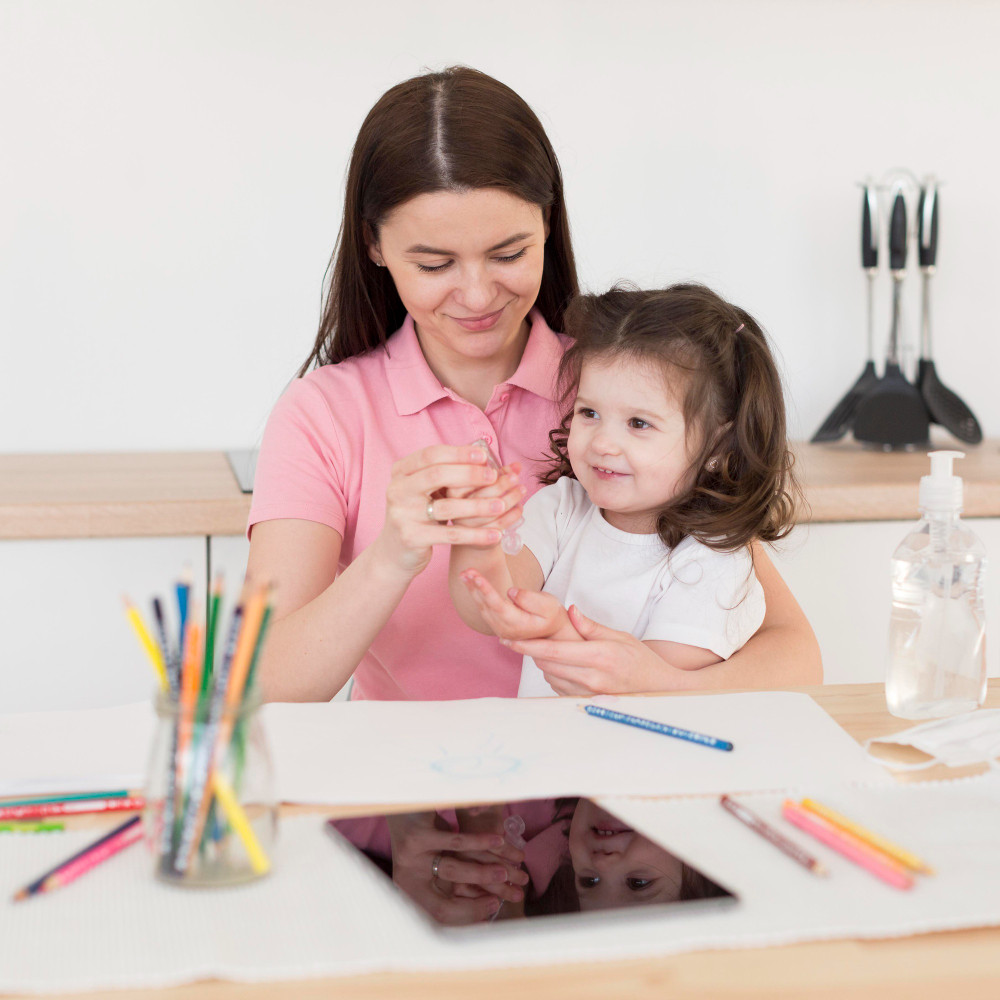
How to Teach Good Manners to Kids at Home: A Complete Parent’s Guide
1. Why Teaching Good Manners to Kids Matters
Good manners are more than just polite words — they’re the foundation of a child’s personality. When parents focus on teaching kids good manners at home, they’re not just showing them how to say “please” or “thank you”; they’re shaping their child’s future character.
Children who grow up practicing manners naturally develop respect, empathy, and confidence. They learn how to interact positively with others, whether it’s greeting guests, showing respect for teachers, or making friends at school. Parents often wonder, “Why do kids need manners at such a young age?” The answer is simple: children mirror what they see and practice. Starting early ensures that politeness becomes second nature.
Another reason manners are important is because they prepare kids for real-life situations. A child who learns to share toys with siblings, wait patiently for their turn, or greet elders respectfully will carry those habits into school, social gatherings, and later, their professional life. Raising polite children isn’t just about appearances — it’s about giving them the tools to build strong relationships.
2. Start with Everyday Politeness at Home
The home is the first classroom, and parents are the first teachers. Kids learn most of their habits by observing their parents, so the best way to teach good manners at home is by modeling them daily.
Start small with everyday politeness:
• Encourage your child to say “please” when asking for something and “thank you” when they receive it.
• Teach them to say “sorry” when they make a mistake and to greet others with a friendly “hello” or “good morning.”
• Involve them in family conversations so they learn how to wait for their turn to speak without interrupting.
Consistency is key. For example, if a child hears you thanking the waiter at a restaurant or apologizing when you bump into someone, they will naturally follow your lead. Children mirror parents’ actions more than words, so teaching kids respect begins with showing respect yourself — to your partner, relatives, and even strangers.
Make it engaging by turning politeness into a game. For instance, keep a “Manners Jar” at home: every time your child remembers to use polite words, add a star or token. At the end of the week, reward them with extra playtime or a fun family activity. This way, good manners become both practical and enjoyable.
3. Teaching Table Manners to Kids
Mealtime is more than just about eating — it’s the perfect opportunity to teach kids important table manners that they’ll carry into school, social gatherings, and family events. Many parents find it challenging, but teaching dining etiquette for kids doesn’t have to be boring. In fact, it can be fun!
• 🌟 Start with the Basics
Begin with simple rules that are easy to remember:
• Wash hands before meals.
• Sit properly at the table without slouching.
• Wait until everyone is served before starting to eat.
• Use “please” and “thank you” when asking for food to be passed.
These little steps make children more mindful and respectful during family meals.
• 🌟 Make Learning Fun
Kids learn faster when they enjoy the process. Turn table manners into a playful challenge:
• Role-play Restaurant: Pretend you’re at a restaurant at home. Let your child be the “guest” and you the “waiter.” Show them how to order politely and use kind words while eating.
• Manners Game: Every time your child remembers a table rule (like not talking with a full mouth), give them a star. Collect stars for a weekly reward.
• 🌟 Lead by Example
Children mirror what they see. If parents chew with their mouth closed, avoid using phones at the table, and speak politely during meals, kids will naturally adopt those same habits. Remember, teaching kids mealtime etiquette is easier when it’s modeled daily.
• 🌟 Focus on Respect
Beyond forks and spoons, table manners also teach children respect and patience. Waiting their turn to be served, not grabbing food, and saying “excuse me” when leaving the table builds discipline and empathy. These little lessons shape a child into someone who respects others’ comfort and feelings.
By practicing regularly, parents can raise kids who feel confident dining in public or with guests — a life skill that will benefit them forever.
4. Encouraging Respectful Communication
Good manners are not just about table behavior — they are also about how kids communicate with others. Teaching children respectful communication at home helps them build strong relationships, express themselves clearly, and show kindness to family, friends, and elders.
• 🌟 Teach Polite Words Early
Start with the magic words: please, thank you, sorry, excuse me. These may sound simple, but they are the foundation of good communication skills for kids. Encourage children to use them in everyday conversations, whether they’re asking for a toy or saying goodbye to a guest.
• 🌟 Practice Active Listening
Respect is not only about talking politely — it’s also about listening. Show kids how to:
• Make eye contact when someone is speaking.
• Wait for their turn instead of interrupting.
• Acknowledge what others say with small responses like “I understand” or “That sounds fun.”
This helps kids feel more confident in conversations while making others feel valued.
• 🌟 Model Respectful Communication at Home
Children copy what they see. If parents speak kindly, avoid yelling, and use respectful tones, kids will follow naturally. For example, instead of saying “Don’t do that!”, try “Can you please stop? It would be better if…”. This gentle communication style teaches kids how to correct others without being rude.
• 🌟 Role-Playing Works Wonders
Turn respectful communication into fun practice:
• Pretend to be a teacher, shopkeeper, or elder relative. Let your child practice greeting, asking questions, and saying thank you politely.
• Swap roles — kids love pretending to be adults, and it helps them understand the importance of tone and body language.
• 🌟 Teach Empathy Through Words
Encourage kids to use words that show care for others’ feelings:
• “Are you okay?”
• “Do you need help?”
• “I’m sorry I hurt you.”
These phrases help children develop emotional intelligence and show compassion in everyday interactions.
By teaching children to speak with kindness and respect, parents prepare them to handle real-life situations confidently — whether it’s talking to teachers, making friends, or resolving conflicts peacefully.
5. Teaching Kids Kindness and Sharing at Home
Kindness is one of the most valuable qualities you can nurture in your child. Along with teaching respect and table manners, showing children how to be kind and share with others lays the foundation for positive social skills and emotional intelligence.
• 🌟 Start with Simple Acts of Kindness
Children learn best when kindness is practiced daily. Encourage small gestures such as:
• Helping a sibling with homework.
• Offering a toy to a friend.
• Saying “good morning” to grandparents or neighbors.
These little actions make kids realize that kindness is not just about big moments — it’s about everyday behavior.
• 🌟 Teach the Joy of Sharing
Sharing is often challenging for young children, but it is key to building cooperation skills. You can encourage sharing by:
• Introducing “family sharing time” where everyone shares something — a story, snack, or favorite toy.
• Praising your child when they willingly share. Positive reinforcement makes them want to repeat the behavior.
• Reading children’s books about kindness and sharing together. Stories help kids visualize why sharing matters.
• 🌟 Model Kind Behavior
Children copy what they see. Show kindness at home by:
• Thanking your partner for small things.
• Helping neighbors or donating unused items to charity.
• Speaking kindly to shopkeepers, drivers, and helpers.
When kids see you being generous and respectful, they naturally adopt the same habits.
• 🌟 Encourage Empathy Through Conversations
Help kids understand feelings by asking questions like:
• “How do you think your friend felt when you gave them your toy?”
• “What would you feel if someone shared their snack with you?”
This helps children connect kindness with emotions and makes sharing more meaningful.
• 🌟 Make Kindness Fun
Turn kindness into a game:
• Create a kindness jar — every time your child does something kind, add a star or note inside. At the end of the week, read them together.
• Play “sharing challenges” where kids earn points for sharing toys, food, or helping a sibling.
By making kindness enjoyable, children learn that being thoughtful and sharing brings happiness to themselves and others.
6. Building Confidence Through Politeness and Respect
Politeness and respect are more than just good manners — they help children develop self-confidence, positive relationships, and a strong sense of self-worth. When kids learn to speak kindly and treat others with respect, they also gain confidence in expressing themselves.
• 🌟 Why Politeness Boosts Confidence
Children who say “please,” “thank you,” and “excuse me” not only appear well-mannered but also feel more comfortable in social situations. These polite words give them a sense of belonging and acceptance, which is essential for building confidence.
For example, a child who confidently greets relatives at a family gathering will feel proud, while others will appreciate their respectful attitude. This positive feedback loop strengthens self-esteem.
• 🌟 Teach Respect for Everyone
Respect begins at home. Encourage your child to respect:
• Parents and siblings – by listening and speaking kindly.
• Elders – by greeting them politely.
• Helpers and staff – by saying thank you to the driver, maid, or shopkeeper.
By showing that everyone deserves respect, you teach kids humility and empathy.
• 🌟 Encourage Confident Communication
Respect is not about staying silent — it’s about speaking kindly. Help kids practice confident yet polite communication:
• Encourage eye contact when talking.
• Teach them to use a calm tone instead of shouting.
• Role-play different scenarios, like ordering food at a restaurant or asking a teacher for help.
This makes children feel secure in expressing themselves while maintaining good manners.
• 🌟 Praise Respectful Behavior
Acknowledging your child’s polite actions is powerful. For example:
• “I really liked how you said thank you to Grandma. That was very kind.”
• “You spoke so politely to the waiter today. I’m proud of you.”
This reinforces respectful behavior and boosts their self-confidence.
• 🌟 Be a Role Model of Respect
Children mirror what they see. Show respect in your tone, words, and actions:
• Speak calmly even during disagreements.
• Thank your child when they do something helpful.
• Avoid harsh or disrespectful words in the home.
When children experience respect firsthand, they naturally pass it on to others.
7. Using Everyday Situations to Reinforce Manners at Home
Teaching manners doesn’t always need special lessons — the best learning happens during everyday routines at home. Children pick up values quickly when they see and practice good manners in real-life situations.
• 🌟 Mealtime Etiquette
Dinner time is the perfect opportunity to practice table manners for kids. Encourage them to:
• Sit properly at the table.
• Wait for everyone before starting.
• Use “please pass the salt” instead of grabbing.
• Thank whoever prepared the food.
This daily practice makes politeness second nature.
• 🌟 Greeting and Welcoming Guests
When relatives or friends visit, teach kids to say hello with a smile, shake hands, or offer a polite greeting. Simple acts like offering water or showing where to sit help children learn hospitality and kindness.
• 🌟 Shopping or Eating Out
Trips to the grocery store or a restaurant are great chances to model respectful communication. Encourage kids to:
• Say “thank you” to the cashier.
• Speak politely to waiters.
• Wait patiently in line without complaining.
These real-world experiences reinforce social etiquette naturally.
• 🌟 Chores and Responsibility
Assigning small chores like setting the table, helping siblings, or cleaning toys teaches kids responsibility, cooperation, and gratitude. Praise them for their efforts — this helps connect manners with positive feelings.
• 🌟 Conflict Situations
Disagreements between siblings are common, but they can be turned into learning moments. Teach kids to:
• Use calm words instead of shouting.
• Listen to the other person’s point of view.
• Say “sorry” when they are wrong.
By practicing conflict resolution, children learn respect, empathy, and emotional control.
• 🌟 Lead by Example
Everyday manners — saying “thank you,” apologizing when wrong, and speaking kindly — should start with parents. When kids see you practicing good manners, they will naturally follow your lead.
8.Conclusion:
Teaching kids good manners at home is one of the greatest gifts you can give them. It’s not about perfection — it’s about building daily habits that reflect kindness, respect, and empathy. By modeling good behavior, making manners fun, reinforcing positively, and introducing cultural perspectives, parents can raise children who are not only polite but also compassionate and confident.
Remember: Good manners start at home but last a lifetime.







